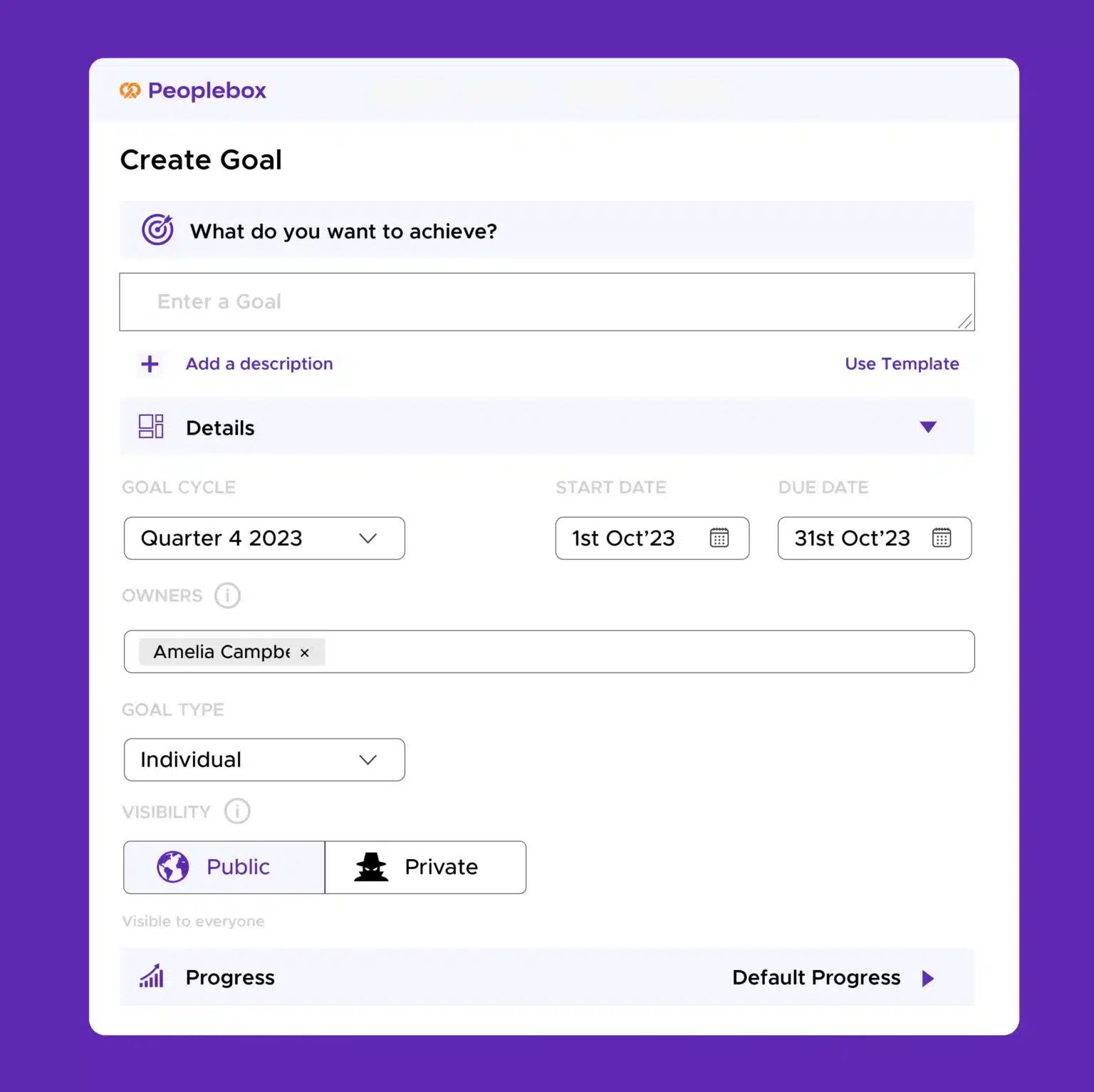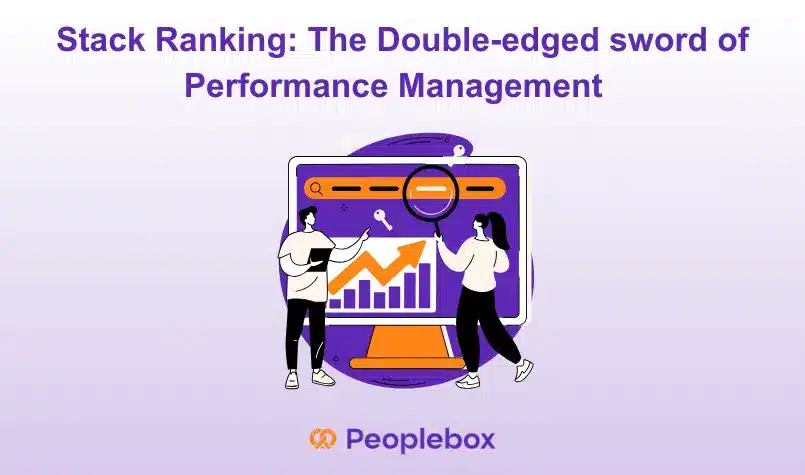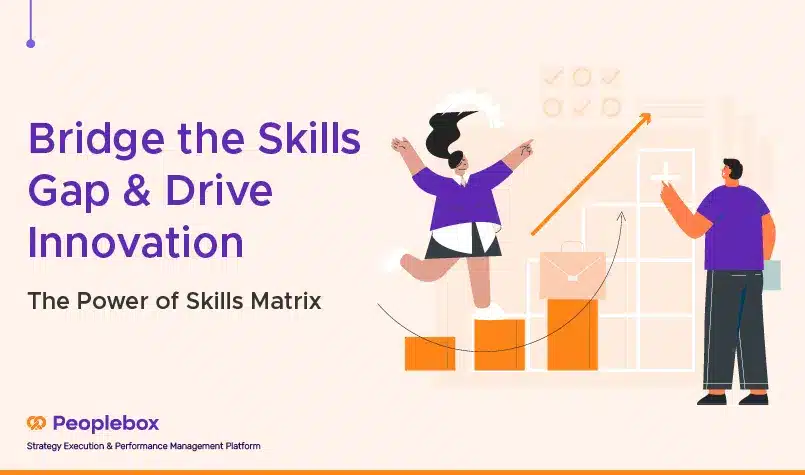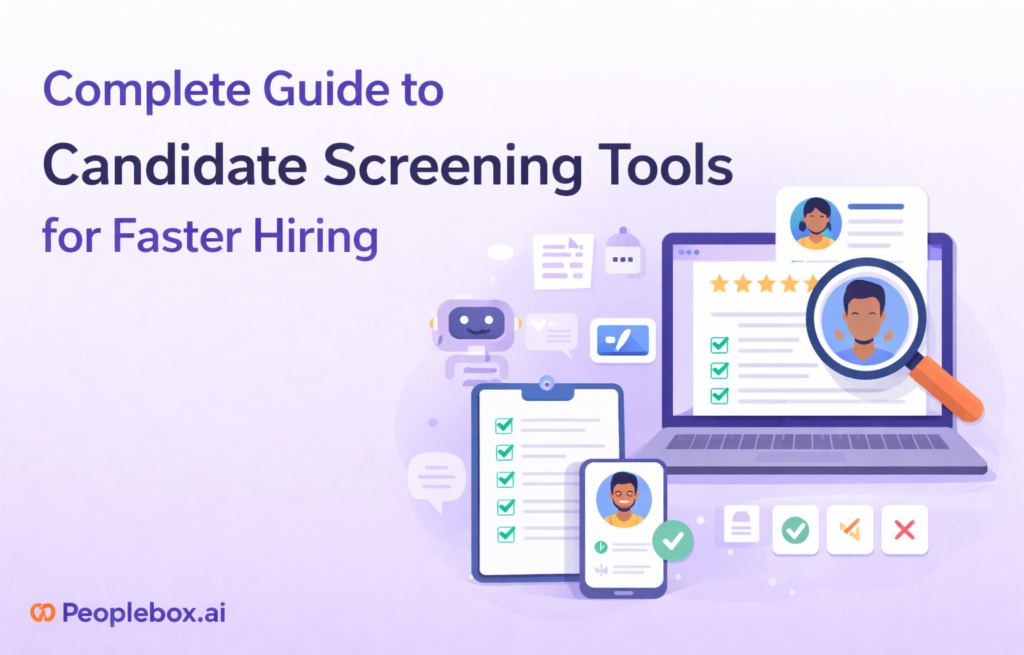After a 2015 New York Times article discussed the internal employee grading system practised at Amazon, the company dropped its evaluation method called stack ranking in 2016. This system was introduced by General Electric’s former CEO, Jack Welch, in the 1980s.
This forced ranking grades employees against their peers to retain the best talent and remove those who do not meet the company’s requirements.
Among the most talked-about (and fiercely debated) aspects of performance management systems, stack rankings have sparked strong opinions on both sides: those who see them as a brutal, damaging, and outdated practice and those who see them as the best way to guarantee a high-performing workforce.
Now, you may wonder.
- What exactly is stack ranking?
- Does it work in today’s employment culture?
- What’s the right way to do it?
- What are the alternatives to performance management and reviews?
We’re about to discuss everything here. So keep reading.
What is Stack Ranking?
Employee stack ranking is an HR evaluation process that grades employees against the performances of others within a team on a bell curve. It’s also called the ‘Rank and Yank’ method. Here, a manager classifies the team members into three categories:
- Top performers – the top 20% of employees with the highest productivity. They are eligible for incentives and promotions.
- Underperformers – the bottom 10% of employees who deliver the least productivity. They are not eligible for performance appraisals and, in most cases, get fired.
- Vital employees – Not as productive as the high performers but still meet the task goals. They receive small raises or incentives and receive training to improve.
In short,
| What stack ranking is | What stack ranking is not |
| A relative performance evaluation | An absolute valuation method |
| A forced distribution (often following a bell curve). E.g., even if all perform well, there must be a low performer. | Usage of rating scales without forced distributions |
| Sometimes called “forced ranking” or “vitality model.” | Always tied to specific metrics (can include subjective assessments) |
Benefits and Drawbacks of Stack Ranking
You must know the pros and cons of stack ranking to understand if it works in 2026. Let’s start with why this approach to performance management might work:
✅Performance differentiation: Stack ranking helps you find the best and least productive performers so you can reward high achievers and address underperformance. Not just that, when you identify performers that need help, you can customize a training or improvement plan.
✅Continuous improvement: When you remove the low-performing employees and replace them with better employees, companies can improve overall team quality. Amazon was said to use this approach to create a completely high-performing workforce. When you give low-performers objectives to work on, it also urges the top ones to consistently perform well.
✅Alignment with company values: As seen in Amazon’s approach, stack ranking can identify key company principles and ensure employees are evaluated against these core values. You can articulate your exact requirements and expect employees to stick to them. So, when they don’t meet them, you can save yourself and the organization from uncomfortable discussions or over-explanation.
✅Structured feedback: The system encourages regular, meaningful conversations between managers and employees about performance and goals. It inspires moderate or midrange employees to work harder and get to the top with granular feedback.
✅Competitive edge: Stack ranking can build a results-driven culture in competitive industries like Wall Street. It brings meritocracy across teams and companies. Meritocracy is a fair method to promote and reward employees purely for their skill and performance.
Alykhan Sunderji, a former Amazon employee and current managing partner at Sunder Legal, commented on stack ranking in the supportive but challenging workplace, saying,
“I still think about those lessons today … And honestly, I feel like I’m a much better lawyer today, because of all of the feedback that I got over nine years.”
But here’s the catch – stack ranking
⛔Prevents collaboration and innovation – Stack ranking prioritizes individual success over teamwork. Employees are less inclined to collaborate or support one another when they see unnecessary internal competition.
⛔Creates a toxic work environment – The continual pressure to outdo one’s colleagues can lead to a toxic work environment. Working conditions can amplify existing feelings of stress, anxiety, and mistrust toward superiors and peers. McKinsey found that toxic working practices influence burnout the most.
⛔Encourages short-term thinking – Employees prioritize short-term gains and observable outcomes above long-term, strategic projects to avoid being placed in the lowest percentiles.
⛔High turnover and associated costs – Regular firing of the “bottom performers” leads to high turnover rates. The constant churn is expensive when you consider the costs of recruiting, hiring, and training new employees.
⛔Potential for bias and unfairness – The performance evaluation process can be subjective when comparing employees across different departments or roles. Personal biases and favouritism can result in unfair evaluations and decisions.
Amy Michaels, former advertising and marketing professional at Amazon, in an NY Times article, said
“When you have so much turnover, the risk is that people are seen as fungible.
You know that tomorrow you’re going to look around and some people are going to have left the company or been managed out.”
The Impact of Stack Ranking on Employee Performance
The impact of using stack ranking to reward or fire employees can be understood by how real-time companies have used it as part of performance management.
📌 General Electric (GE) Jack Welch introduced GE’s “Vitality Curve,” which initially seemed successful. Welch believed it doubled GE’s revenue in the 1980s and 1990s. However, General Electric has since moved away from this approach to more modern continuous performance management systems as it no longer motivates employees.
📌 Amazon used stack ranking but with a twist. Instead of immediately firing low performers, they implemented a three-month “Performance Improvement Plan.” It aimed to help underperforming employees improve rather than simply eliminate them. However, Amazon has since distanced itself from stack ranking because of its limitations in building long-term employee development.
📌 Google implemented a modern approach to stack ranking versions to identify candidates ready for promotion. Notably, there were no negative consequences for lower-ranked employees. It shows how ranking employees can be adapted to focus on positive outcomes rather than punitive measures.
📌 Microsoft used stack ranking, where managers assigned predefined percentages to high, average, and low performers on a scale when rating their teams. This practice was terrible for motivation, company growth, and innovation, as workers were more interested in competing with one another than in working together. Thus, even Microsoft was forced to stop using it in 2012.
When to Use a Stack Ranking System
This overview should give you an idea of when to go ahead (green), proceed with caution (yellow), and reconsider (red) using the stack ranking approach.
| 🟢 Proceed | 🟡 Proceed with caution | 🔴 Stop and reconsider |
| You’re in a high-stakes industry like tech or manufacturing. | Some roles are individual, others team-based. | Your success depends heavily on teamwork. |
| Success hinges on specific, measurable skills. | You’re still refining how you are effectively measuring employee performance. | Performance is often affected by factors outside employee control. |
| When you’re on a budget crunch, but must prioritize top performers. | The budget for rewards varies from year to year. | Losing lower-ranked employees could mean critical knowledge loss. |
| You have well-defined, quantifiable performance indicators. | You value diverse skills, some more measurable than others. | You’re focusing on improving employee morale and organizational trust. |
| Work is primarily individual rather than collaborative. | You’re in a changing sector where competition is increasing. | Performance in your field is difficult to quantify objectively. |
Implementing a Stack Ranking System Effectively
The stacked ranking system has had a mixed impact on several companies, so it’s important to know how to implement it correctly.
Step 1: Define your performance criteria
- Set measurable, company-aligned criteria.
- Engage staff for transparency
Step 2: Collect performance data
- Collect data through quantitative and qualitative methods
- Check-in on employees’ progress often.
- Prompt managers to communicate openly with their staff.
Step 3: Rank employees and communicate
- Maintain department-wide uniformity in approach
- Sort workers into predefined groups
- Give personalized feedback and justification
Step 4: Implement consequences and rewards
- Give out incentives, development opportunities, or promotions
- Use re-assignment or performance-improvement plans to fix underperforming employees.
Step 5: Ensure fairness
- Prioritize based on measurable outcomes
- Make use of peer reviews to reduce bias
- Hold calibration sessions to ensure uniformity
- Provide an appeals procedure to resolve issues
Step 6: Review and adjust
- Check the system’s performance on a regular basis.
- Make changes in response to feedback and business requirements.
Alternative Performance Management Approaches
Stack ranking does manage employee performance, but you must implement the right performance management strategies considering the way the modern workforce functions. Here are the best alternative performance management approaches to maintain productivity across all employee levels and workplace culture.
Continuous performance management
Continuous performance management process prioritizes ongoing coaching, development, and feedback instead of depending solely on rankings. It incorporates goal planning, weekly check-ins, and real-time feedback to help employees learn and improve consistently.
Instead of forcing employees to rank one another, as stack ranking promotes, you must focus on conducting frequent employee performance reviews that encourage professional growth.
360-degree feedback
360-degree feedback is an approach that considers input from every dimension of an organization: managers, coworkers, clients, and subordinates. Employees are 3.2 times more likely to be inspired to perform exceptionally when they receive ongoing feedback from their bosses rather than yearly reviews.
With this system in place, workers will objectively assess their own performance, get constructive criticism from supervisors, and learn about the opinions of their coworkers based on their own experiences and viewpoints. Additionally, there are the perspectives of both internal and external clients, including stakeholders on various teams and product users.
Psychological appraisals
Psychological appraisal does not focus on an employee’s previous performance but examines how they might perform going forward.
An employee’s mental health is evaluated through confidential discussions, psychological testing, and in-depth interviews led by a licensed psychologist. The psychologist examines things like EQ, leadership potential, personality quirks, intellectual ability, intelligence quotient, and interpersonal skills.
Objectives and Key Results (OKRs)
Organizations such as Google, Spotify, and Twitter use the Objectives and Key Results (OKRs) goal-setting approach to establish quantifiable objectives in their performance management procedures.
OKRs allow individuals to work toward a standard “result” through individual goals rather than setting entirely separate goals. They also shift the emphasis from results to outputs. For instance, under a conventional goal-setting framework, a marketing manager would be required to produce six ebooks annually to boost leads.
They may set a primary goal of increasing leads by 30% in a year using OKRs, and they may do it with just one outstanding ebook. By doing this, you can transition from “working hard” to “working smart.”
Project-based reviews
With this method, an employee’s performance is assessed according to how they contributed to particular initiatives. Their capacity to effectively collaborate, manage their workload, and produce good results is evaluated.
Project-based reviews benefit employees who operate in cross-functional teams or project-driven roles. They help organizations close the feedback gap. Through the reflective process of project reviews, employees can assess the success of one task, pinpoint areas for improvement, and create an action plan to boost performance strategically going forward.
Best Practices for a Fair and Effective Ranking System
The following best practices will help you refine your stack ranking ideas and ensure fair ranking system management that employees will appreciate and get inspired by.
✔ Set agile goals: Performance management starts with goals. But people don’t realize there is a simple way to chunk down long-term goals into smaller, more manageable chunks—key results. When this happens, they will be a far more useful tool for managers and staff.
💡Pro tip: OKR frameworks can be a great option here. All stakeholders can monitor continuous improvement more easily when objectives and key results, or “OKRs,” are clear, quantifiable and allow for evolution over time.
✔ Communicate through regular meetings: Setting up regular meetings gives managers and staff a wonderful chance to discuss performance thus far and how to better accomplish goals.
💡Pro tip: These check-ins should feel more like empowering and cooperative discussions than interrogations. The environment and tone should reflect that both sides are building and evaluating performance.
✔ Offer 360-degree feedback: The idea behind this best practice is “Anytime, anywhere, anyone.” Providing employees with consistent feedback helps them understand their expectations and builds trust between managers and employees. Not only that, but feedback shouldn’t be top-down and one-way. Instead, it is important to provide criticism using a comprehensive, 360-degree perspective.
💡Pro tip: While you might want to ask insightful questions to elucidate meaning, refrain from interrupting the employee while they are speaking. Before continuing, summarize the discussion and confirm mutual insight into future expectations.
✔ Involve employees in the design: Employees must believe they are helpful for performance management procedures to be successful and interesting. Thus, businesses need to consider their employees’ perspectives. The best strategy to increase employee engagement is to ask them to participate in co-creating this experience.

💡Pro tip: Performance management systems like Peoplebox help your staff quickly define quantifiable goals and ensure they operate per the company’s objectives.
Wrapping Up
A good performance management process is not a one-time thing; it’s an ongoing effort. Most firms use such systems to evaluate employee performance and set performance appraisals, but it has potential beyond performance improvement programs.
Peoplebox is an all-inclusive platform for managing performance that links objectives, key performance indicators (OKRs), coaching, feedback, and reviews. The absence of switching between different tools greatly simplifies the performance review process.
When you use Peoplebox, you can conduct the full performance review cycle — which includes management feedback, 360-degree assessments, and employee self-assessments — right within Slack. Sign up for a quick free demo with us!






